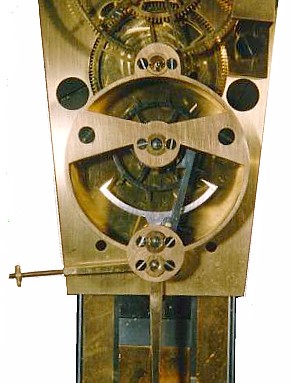






 |
 |
 |
 |
|||
 |
 |
 |
||||
|
|
|
|
After graduation, I worked for two years at the Hamilton Watch Co. working on Hermle movements. In addressing the problems of the comebacks, I learned valuable skills like how to prick punch a worn bushing without taking the plates apart. We were told to throw out the movement if we couldn't fix it in an hour. On April fools day of 1977, I moved to New York City, the only certifiably Connecticut clock free zone in the United States. My first job was with a gentleman who ran a clock shop on 9th Avenue in Hells Kitchen, who may have been the worst clockmaker in the city. He fired me for incompetence after two weeks. After various other employment adventures with New York clock repair shops, I ended up at F. P. Victoria & Son, an antique shop catering to the interior design trade on E. 55th Street. |
|
| In November of 1999 the building that housed the Arcadian Clock Co for almost 19 years was sold, and we moved, on short notice, to suburban New Jersey. This was a considerable disruption in operations, but a benefit in that we were able to expand our machine shop facilities and focus more on the creative aspects of horology. In September of 2000, Erika Johnson joined the business. Starting as a trainee, she has increasingly mastered the skills of clock restoration, manual machining, and together we have delved into the mysteries of computer numeric control machining. We look forward to a period of fertile artistic endeavors. We believe that the art of horology is limited only by the imagination of its practitioners. |
|
|
|
||
|
The Munro No. 2 Early in my tenancy at his establishment, Tony Victoria came to me with a question. His father, in the 1950‘s, had built a Louis Quinze style lacquered wall regulator case to house an antique movement. Tony had since returned the movement to it's original case and he wanted a new movement made for his father’s case. The clock I built has a gridiron pendulum, month duration, a differential equation train, where the additional motion work gearing is in a counterpoised frame which pivots between fixed pivots. It incorporates a 365 day calendar train, and has five concentric hands. The clock won a first prize for complicated clock movements at the NAWCC craft competition, my first of two such honors. Considering that this was the first serious clock I built, I am still proud of the design and quality of the execution of the movement. |
|
The Munro No. 3 My next clock was built on commission for a gentleman in Connecticut who challenged me to build a clock which did something entirely new. Well as you may know, almost everything has been done before in horology. Inspired by Robin floor regulators with hidden remontoires, I proposed a similar movement that would adjust for Daylight Savings Time. The minute wheel is on a little bridge which pivots around the center arbor. It flips from one position to the other on the Sunday of the time change, moving the hour hand to the correct position. |
|
Munro
No. 4-6
|
 |
|
The
Arcadian Clock Co. (908) 276-0276
©2012 The Arcadian Clock Co. |